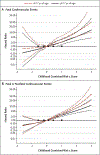Childhood Cardiovascular Risk Factors and Adult Cardiovascular Events
- PMID: 35373933
- PMCID: PMC9563825
- DOI: 10.1056/NEJMoa2109191
Childhood Cardiovascular Risk Factors and Adult Cardiovascular Events
Abstract
Background: Childhood cardiovascular risk factors predict subclinical adult cardiovascular disease, but links to clinical events are unclear.
Methods: In a prospective cohort study involving participants in the International Childhood Cardiovascular Cohort (i3C) Consortium, we evaluated whether childhood risk factors (at the ages of 3 to 19 years) were associated with cardiovascular events in adulthood after a mean follow-up of 35 years. Body-mass index, systolic blood pressure, total cholesterol level, triglyceride level, and youth smoking were analyzed with the use of i3C-derived age- and sex-specific z scores and with a combined-risk z score that was calculated as the unweighted mean of the five risk z scores. An algebraically comparable adult combined-risk z score (before any cardiovascular event) was analyzed jointly with the childhood risk factors. Study outcomes were fatal cardiovascular events and fatal or nonfatal cardiovascular events, and analyses were performed after multiple imputation with the use of proportional-hazards regression.
Results: In the analysis of 319 fatal cardiovascular events that occurred among 38,589 participants (49.7% male and 15.0% Black; mean [±SD] age at childhood visits, 11.8±3.1 years), the hazard ratios for a fatal cardiovascular event in adulthood ranged from 1.30 (95% confidence interval [CI], 1.14 to 1.47) per unit increase in the z score for total cholesterol level to 1.61 (95% CI, 1.21 to 2.13) for youth smoking (yes vs. no). The hazard ratio for a fatal cardiovascular event with respect to the combined-risk z score was 2.71 (95% CI, 2.23 to 3.29) per unit increase. The hazard ratios and their 95% confidence intervals in the analyses of fatal cardiovascular events were similar to those in the analyses of 779 fatal or nonfatal cardiovascular events that occurred among 20,656 participants who could be evaluated for this outcome. In the analysis of 115 fatal cardiovascular events that occurred in a subgroup of 13,401 participants (31.0±5.6 years of age at the adult measurement) who had data on adult risk factors, the adjusted hazard ratio with respect to the childhood combined-risk z score was 3.54 (95% CI, 2.57 to 4.87) per unit increase, and the mutually adjusted hazard ratio with respect to the change in the combined-risk z score from childhood to adulthood was 2.88 (95% CI, 2.06 to 4.05) per unit increase. The results were similar in the analysis of 524 fatal or nonfatal cardiovascular events.
Conclusions: In this prospective cohort study, childhood risk factors and the change in the combined-risk z score between childhood and adulthood were associated with cardiovascular events in midlife. (Funded by the National Institutes of Health.).
Copyright © 2022 Massachusetts Medical Society.
Figures


Comment in
-
Childhood Risk Factors and Prediction of Adult Cardiovascular End Points.N Engl J Med. 2022 May 19;386(20):1948-1949. doi: 10.1056/NEJMe2203743. Epub 2022 Apr 4. N Engl J Med. 2022. PMID: 35373934 No abstract available.
-
Childhood cardiovascular risk factors lead to heart disease in adults.Nat Rev Cardiol. 2022 Jun;19(6):349. doi: 10.1038/s41569-022-00707-8. Nat Rev Cardiol. 2022. PMID: 35440739 No abstract available.
-
A life-course approach to cardiovascular disease prevention.Nat Med. 2022 Jun;28(6):1133-1134. doi: 10.1038/s41591-022-01870-8. Nat Med. 2022. PMID: 35681104 No abstract available.
-
Childhood Risk Factors and Adult Cardiovascular Events.N Engl J Med. 2022 Aug 4;387(5):472. doi: 10.1056/NEJMc2208135. N Engl J Med. 2022. PMID: 35921461 No abstract available.
-
Childhood Risk Factors and Adult Cardiovascular Events.N Engl J Med. 2022 Aug 4;387(5):472-473. doi: 10.1056/NEJMc2208135. N Engl J Med. 2022. PMID: 35921462 No abstract available.
-
Childhood Risk Factors and Adult Cardiovascular Events.N Engl J Med. 2022 Aug 4;387(5):473. doi: 10.1056/NEJMc2208135. N Engl J Med. 2022. PMID: 35921463 No abstract available.
-
Childhood cardiovascular risk factors associated with adult cardiac events.J Pediatr. 2022 Oct;249:117-120. doi: 10.1016/j.jpeds.2022.06.033. J Pediatr. 2022. PMID: 36216473 No abstract available.
-
A Call for Australian Clinical Practice Guidelines for Paediatric Hypertension.Heart Lung Circ. 2023 Sep;32(9):1032-1034. doi: 10.1016/j.hlc.2023.06.726. Epub 2023 Jul 24. Heart Lung Circ. 2023. PMID: 37495429 No abstract available.
References
-
- Virani SS, Alonso A, Benjamin EJ, et al. Heart disease and stroke statistics — 2020 update: a report from the American Heart Association. Circulation 2020;141(9):e139–e596. - PubMed
-
- Raitakari O, Pahkala K, Magnussen CG. Prevention of atherosclerosis from childhood. Nat Rev Cardiol 2022. January 5 (Epub ahead of print). - PubMed
Publication types
MeSH terms
Substances
Grants and funding
LinkOut - more resources
Full Text Sources
Medical
